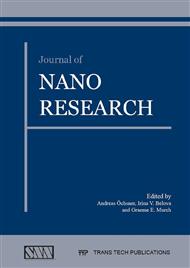[1]
K. Hashemnia, M. Farid, V. R., Vibrational analysis of carbon nanotubes and graphene sheets using molecular structural mechanics approach, Comp. Mater. Sci. 47 (2009) 79-85.
DOI: 10.1016/j.commatsci.2009.06.016
Google Scholar
[2]
C.G. Wang, L. Lan, Y.P. Liu, H.F. Tan, X.D. He, Vibration characteristics of wrinkled single-layered graphene sheets, Int. J. Solids Struct. 50 (2013) 1812–1823.
DOI: 10.1016/j.ijsolstr.2013.02.002
Google Scholar
[3]
R.D. Firouz-Abadi, A.R. Hosseinian, Free vibrations of single-walled carbon nanotubes in the vicinity of a fully constrained graphene sheet, Comp. Mater. Sci. 53 (2012) 12–17.
DOI: 10.1016/j.commatsci.2011.09.010
Google Scholar
[4]
I.E. Berinskii, A.M. Krivtsov, A.M. Kudarova, Bending stiffness of a graphene sheet, Phys. Mesomech. 17 (2014) 356-364.
DOI: 10.1134/s1029959914040134
Google Scholar
[5]
A. Muc, M. Chwał, Vibration control of defects in carbon nanotubes, in: G. Stépán, L.L. Kovács, A. Tóth (Eds. ) IUTAM Symposium on Dynamics Modeling and Interaction Control in Virtual and Real Environments, Springer Netherlands, Netherland, 2011, pp.239-246.
DOI: 10.1007/978-94-007-1643-8_27
Google Scholar
[6]
Z. Ebrahim Zadeh, M. Yadollahpour, S. Ziaei-Rad, F. Karimzadeh, The effect of vacancy defects and temperature on fundamental frequency of single walled carbon nanotubes, Comp. Mater. Sci. 63 (2012) 12-19.
DOI: 10.1016/j.commatsci.2012.05.045
Google Scholar
[7]
R. Maleki Moghadam, S.A. Hosseini, M. Salehi, The influence of Stone–Thrower–Wales defect on vibrational characteristics of single-walled carbon nanotubes in corporating Timoshenko beam element, Physica E, 62 (2014) 80-89.
DOI: 10.1016/j.physe.2014.04.008
Google Scholar
[8]
M. Amjadipour, D.V. Dao, N. Motta, Vibration analysis of initially curved single walled carbon nanotube with vacancy defect for ultrahigh frequency nanoresonators, Microsys. Technol. (2015) 1-6.
DOI: 10.1007/s00542-015-2470-2
Google Scholar
[9]
S. Imani Yengejeh, A. Öchsner, Influence of structural imperfections-twisting and distortion-on the vibrational behavior of carbon nanotubes, J. Nanoeng. Nanosys. (2015) 1740349915579713.
Google Scholar
[10]
Z. Kang, M. Li, Q. Tang, Buckling behavior of carbon nanotube-based intramolecular junctions under compression: Molecular dynamics simulation and finite element analysis, Comp. Materi. Sci. 50 (2010) 253-259.
DOI: 10.1016/j.commatsci.2010.08.011
Google Scholar
[11]
A. Öchsner, M. Merkel, One-Dimensional Finite Elements: An Introduction to the FE Method, Springer-Verlag, Berlin, (2013).
Google Scholar
[12]
S. Imani Yengejeh, S.A. Kazemi, O. Ivasenko, A. Öchsner, A refined finite element analysis on the vibrational properties of ideal and degenerated carbon nanostructures, Solid State Commun. 231-232 (2016) 36-42.
DOI: 10.1016/j.ssc.2016.01.015
Google Scholar
[13]
H. Xin, Q. Han, X. -H. Yao, Buckling and axially compressive properties of perfect and defective single-walled carbon nanotubes, Carbon, 45 (2007) 2486-2495.
DOI: 10.1016/j.carbon.2007.08.037
Google Scholar
[14]
A.M.A. Huq, A.K. Bhuiyan, K. Liao, K.L. Goh, Defect–defect interaction in single-walled carbon nanotubes under torsional loading, Int. J. Modern Phys. B 24 (2010) 1215-1226.
DOI: 10.1142/s021797921005510x
Google Scholar
[15]
A.R. Ranjbartoreh, G. Wang, Effect of Topological Defects on Buckling Behavior of Single-walled Carbon Nanotube, Nanoscale Res. Lett. 6 (2011) 28-33.
DOI: 10.1007/s11671-010-9776-x
Google Scholar
[16]
S. Imani Yengejeh, M. Akbar Zadeh, A. Öchsner, Numerical modeling of eigenmodes and eigenfrequencies of hetero-junction carbon nanotubes with pentagon–heptagon pair defects, Comp. Mater. Sci. 92 (2014) 76-83.
DOI: 10.1016/j.commatsci.2014.05.015
Google Scholar
[17]
S. Imani Yengejeh, S.A. Kazemi, A. Öchsner, Advances in mechanical analysis of structurally and atomically modified carbon nanotubes and degenerated nanostructures: A review. Composites Part B: Engineering 86 (2016) 95-107.
DOI: 10.1016/j.compositesb.2015.10.006
Google Scholar


